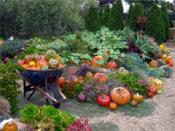Search
Login
Treelike peonies, their varieties, growing characteristics and recommendations for care. Landscape peony tree
Tree peonies have become relatively popular among amateur gardeners in our country relatively recently. But in other countries, in particular China, this amazingly beautiful plant has been cultivated for more than one and a half thousand years, moreover, it is revered and enjoyed by love as a flower-symbol of the whole people. The Latin name for the peony is Paeonia suffruticosa, it belongs to the pion family. China is considered the birthplace of the plant, but some of its species are found as growing in the territory of the ancient region of Thrace, which was called Peonia. There is even a version that the plant owes its name to it. Another legend says that the word peony was formed from the Greek paionis, i.e. healing, one that heals. The plant itself since ancient times is considered a symbol of longevity and wealth.
Content
- Plant description video
- Varieties of peony tree
- We select a place for landing
- Tree peonies - seedling care video
- Breeding methods
- We plant bushes in a permanent place video
- Diseases and Pests
- Tree peony in garden design
Plant description

The plant has a very attractive and decorative look, not only during the flowering period, but throughout the summer-autumn season, you can admire the beauty of the plant by looking at the tree-like peony in the photo. The bush can reach a height of 2 m, but usually it reaches from 1 to 1.5 m. Thick, branched shoots are erect, densely overgrown with very bright, double-pinnate ornamental leaves. The openwork of the leaves gives the plant a special sophistication.

But if you do not say how peonies bloom in this way, it means saying nothing at all about them. With the onset of spring heat, large buds appear on the annual shoots, gradually opening, they turn into amazingly beautiful flowers, the diameter of which can reach from 15 to 22 cm. Different varieties of peony have simple flowers, the number of petals from 6 to 12 or double, very tightly clogged with petals. Sometimes they are so heavy that they break branches. Flowers of any of the varieties are distinguished by an amazing delicate aroma. The number of flowers on an adult plant can reach from 50 to 100 pieces.

Shades of petals can be the most variegated: from white to burgundy, yellow, pink, raspberry and lilac, but their common characteristic is the presence of dark raspberry patches at the very base of the flower.
Varieties of peony tree

About 500 different plant varieties are grown in the world today. Most of them are bred in China. The most common and popular among gardeners:
- hybrids with pinnate long leaves and flowers, the diameter of which reaches 25 cm
- dwarf hybrids
- hybrid Lemoine with large orange and yellow flowers with a diameter of 15 cm.

Specialists subdivide all known varieties into the following groups:
- japanese, characterized by semi-double or simple flowers, airy and light
- sino-European having heavy double flowers
- hybrids of peony Delaway and yellow with semi-shrub varieties.
The differences between the varieties of tree peony in the plant photo are visible quite clearly.
We select a place for landing

Planting a tree peony should be done in partial shade, but not in close proximity to trees or buildings. Although the plant can survive on soils of any type, it is advisable to give preference to permeable loam, with good drainage, somewhat elevated. Plants should not be planted on clay soil, in a swampy area or a section with stagnant waters. A good result will not work when planting it in acidic soil - the peony will be stunted, its leaves will have an unnatural reddish tint.
Tree peonies - seedling care

Experts recommend planting the purchased seedlings either in early spring or in September, so that plants can take root well before frost. If it was not possible to plant the plants in September, it is better to plant it in a pot or box and keep it all winter in a cool place. Maximum at +10 degrees C, preventing the soil from drying out in the tank. Since the plants begin to develop very early, it is not recommended to delay them with spring planting in open ground. Saplings throughout the summer will require moderate soil moisture, loosening, top dressing, for which you can use bird droppings infusion (1:20). It will be possible to land them at a permanent place after the first flowering, if possible at the end of August.
Active flowering usually occurs in the third year. To allow it to grow stronger and form a strong root system, the flowers are removed after wilting. Ripening seeds will greatly deplete the young plant. It is not recommended to allow flowering in the first year after planting - the flowers are cut off in the bud phase.
Peony should not be cut off - only dried shoots, usually 2-3 year old, should be removed.
Preparation for wintering consists in sprinkling the area around with peat or hilling with soil, plants can be covered with spruce branches, but not with straw or leaves.
To use acid fertilizers or manure for feeding is not recommended. Potash, nitrogen, phosphorus fertilizers are applied either at the end of winter directly in the snow, or at the very beginning of spring. The plant is also fed during the formation of buds with mandatory subsequent watering.
Peony propagation methods
There are several ways to propagate a tree peony:
- root cuttings and stem
- kidney renewal
- layering
- seeds.
Most often resort to bush division. It should be made in such a way that each part has from 3 to 5 stems and 3-4 roots, not less than 15 cm long. To avoid infection, the sections are immediately covered with crushed coal mixed with sulfur (1: 1). Before landing in the ground, a 1% solution of copper sulfate is treated.

When propagated by receiving layering they press young twigs to the ground, make sure that the soil is sufficiently moistened. A variant of air discharge is also possible. With green cuttings, difficulties may arise with the wintering of rooted cuttings.
Breeding seed - the simplest method, but requiring patience. Since the embryo is underdeveloped in the seeds, they must be subjected to stratification. First stage:
- withstand crops at temperatures up to +30 degrees for 18 hours a day. the rest of the time - at 18, until the roots appear (warm stratification)
- further - until the first leaf appears - at a temperature of about +6 degrees C (cold phase). Tanks with shoots are kept outdoors since the beginning of May.
They are planted in the soil at the end of August, at a distance of not less than a quarter meter from each other. A site with young animals should be mulched and spud for the winter - this will help protect plants from frost and temperature extremes.

Such bushes will be able to please flowers only after transplanting to a permanent place, at 4 or 5 years of their life. So, for those who want to quickly decorate the garden with this truly royal plant, it is easiest to buy a tree peony in the form of a divided bush.
Experienced flower growers also practice tree peony propagation. vaccinated. As the rootstock, the roots of tree-like or grassy peonies are used. Carry out the procedure in early August. In this case, only young shoots serve as a vaccine. Most often resort to performing a wedge-shaped cut. The thickness of the stock should be commensurate with the thickness of the cuttings, the recommended spine length is 15-17cm. The ideal option is if there are two eyes on the handle. Vaccination is carried out in the usual way: the graft is inserted into the stock, while making sure that the surfaces are perfectly smooth, then they are wrapped with tape, the adhesive side out. Leaflets from the stalk are removed.

To improve the survival rate, grafted plants are placed in boxes and covered with moistened sawdust. After a month they are planted in a greenhouse, watered, protected from direct sunlight.
At side vaccination both the graft and the root are cut at the smallest possible angle, combine them and tightly bind. The vaccination site is coated with garden var.
We plant bushes in a permanent place

It is difficult to overestimate the importance of this moment: the life span of a plant can reach hundreds or even more years, so more than one generation will most likely admire the results of your work. The acquisition of a tree peony, planting and care of it, in accordance with the recommendations of specialists, will ensure that your site has a surprisingly beautiful and decorative decoration.
To ensure a comfortable stay, we will choose for landing
- the place is warm
- sheltered from the winds
- with fertile, loose soil.
Proper drainage can be ensured by laying sand and gravel pits on the bottom, the thickness of the drainage layer is up to 20 cm. You can prepare the pit for planting in advance, its diameter for an adult plant should reach 80 cm, the bottom should not be less than 40 cm in diameter. the bottom of the pit is laid with drainage material, then a layer of humus, if the soil is acidic, add up to 250 grams of lime. From peat, soil and humus, we prepare the soil mixture, add 100 g of superphosphate, 400 g of bone meal to it. If the clay soil should add half a bucket of clean river sand, if the sand - half a bucket of clay, mix thoroughly.

When digging up a bush, damage to small roots should be avoided. When planting, the roots, together with a lump of earth, are placed in a prepared pit with a soil mixture, poured with water. Landing is done in half an hour. The root neck of the plant should be located at the level of the soil surface. With a deep planting, active flowering of the bush will most likely not be observed, as well as with too shallow. Watering the plant can be done with water with the addition of a weak solution of potassium permanganate.
If there is a threat of flooding the site, then artificial hills are built to plant the plants. If plants are planted in a group, then it should be noted that for their normal life, the distance between the bushes should not be less than 1.3 - 1.5 m.
The grafted plants are planted deep enough, 8-10 centimeters deeper than the grafting site, this will enable the cuttings to take their own roots, the plant will become more strong and hardy.
Frequent transplantation of a tree peony is not desirable. The plant painfully refers to this procedure, but if the shoots of the transplanted plant seem dried up and throw it away, take your time - new shoots can form from the accessory buds on the base of the stems.
Diseases and Pests
The most common disease to which the plant is exposed can be called gray rot. The cause of its occurrence may be:
- excess nitrogen in the soil
- growing in a very shaded area
- very high humidity.

You can avoid the occurrence of the disease by choosing the right place for planting and quality care. if lesions with gray rot are still observed, then at the beginning of the growing season, cut the affected branches at a height of about 15 cm, immediately burn them.
Tree peony in garden design

The luxurious shape and color suggest that you should not resort to planting a continuous strip of bushes. The best option is to create groups of 3 bushes at the corners of the ground. It is best to observe flowering from a close distance, in addition, flowering is accompanied by an amazing aroma, it is best to provide the possibility of direct access to the planted bushes. You can build a bench near the planted peonies to relax - this will allow you to more fully enjoy the beauty of flowers and picturesque leaves.
If desired, planting peonies can be used as a natural green barrier near the resting place in the garden.
But in order for the peony bushes to look more impressive in landscape design, they should be arranged in such a way as to ensure that there is free space around them. Extremely impressive can look even separately luxurious bush growing on the lawn. Large plants located on the corners of garden paths or near beautiful fences look charming.





